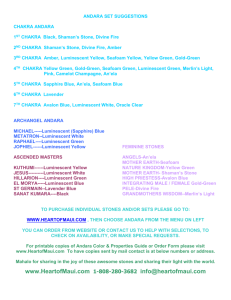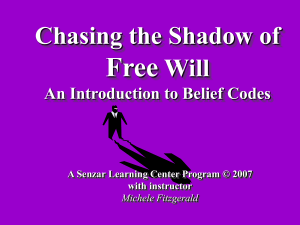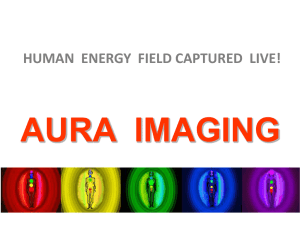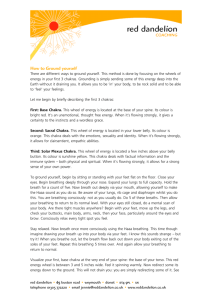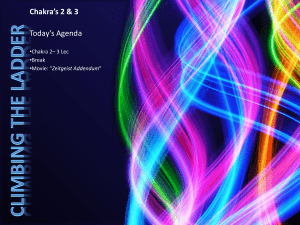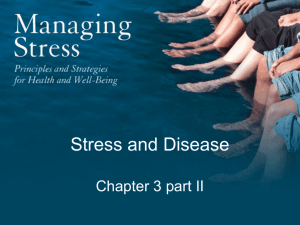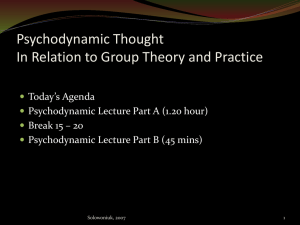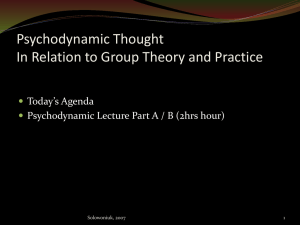Document 16066663
advertisement
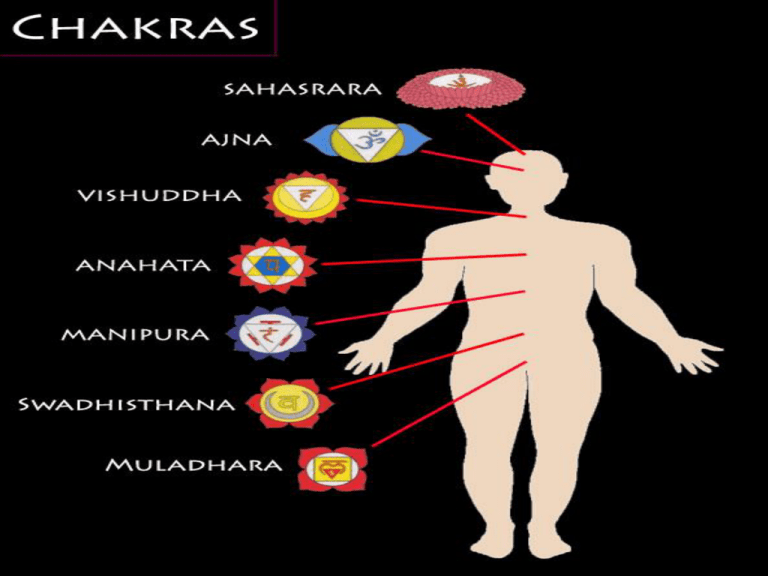
Short Chakra Video • Introducing the Chakra’s (Judith) • Muladhara Chakra Base or Root Chakra Muladhara (pronounced as Moola Dar Uh) • The Muladhara Chakra is located at the base of the spine. • The word Muladhara in Sanskrit means Foundation. • It is this Chakra that anchors us to our grounding connection to and root support from the Universal Source of All That Is, to our center within, to our foundation. Spiritual / Consciouness Growth • Spiritual growth through the chakra’s is a process of incorporating even-larger areas of the ground into the self. • Chakra’s are not created by ego or self. • Living energy system within the physical body connecting physical the spiritual • As we connect to the physical body we connect to each other and to the infinite web of life toward the adoption and returning to pure consciousness. • Alas, like climbing a ladder… Thus the Chakra’s are rungs connected together by the spiritual ground. Climbing the Ladder • As one ascends each chakra this activates a series of fundamental resonances that sets patterns for each stage of life. • Higher chakra’s grant access to greater quantities of information and wisdom. • While lower levels never disappear, optimal spiritual growth requires that lower chakra’s enfold into higher. • While all humans seek unity, life offers no guarantee that each stage will march in unison or will be free to open naturally. Ladder Derailment / Block / Cracking • When chakra’s open out of phase, are blocked, or are closed, psychotic ASC’s may arise or be imprinted to arise later in life. • 3 Types • Fixation (arrest of growth) • Repression (abuses) • Intrusion (ego rupture by SP) First Chakra Developments • Jason add tomorrow! Moving From Level to Level: Ego Death • Moving from level to level requires the developing self/ego to relinquish previous chakra attachment • Feels like psychic death… “because it is” First Chakra: Spiritual, Psychological Development and Impingement • Life in the Womb – Fetus resonates with outside environment – Mom / Dad • Birth Trauma – Imprinting (laying down pathways) – Psychosis predisposition – Repression Mother / Father Infant Bond • Unitary consciouness inside womb • Upon exit from birth canal infant seeks for loving secure object to begin the task of making sense of things • Searches intuitively for these things in mother / father / primary caregiver – – – – • Face patterns Smell Tastes Voices After all the sense of security and presence of the ground usually made the womb a place of “oneness”. Spirit to Spirit Resonance or Failure • For better or worse, without a closed boundary enclosing consciouness these early resonances set the stage for trusting the world and an existence beyond the undifferentiated matrix. • Hence, as the infant emerges into the world he or she must negotiate the “I/not-I” split and the vacant emptiness in the absence of primary caregiver. • This is also in the face of the ego’s early identification with the body as “I”. Margaret Mahler’s Theory of Ego Development • These early repetitions of cleaving spirit into matter, and matter into ego, is what Margaret Mahler called the separation individuation process. Solowoniuk, 2007 12 Towards An Object-Related Developmental Understanding of Madness and Addiction: Building an Ego • Self-Object: mental representations of others that we experience as part of ourselves; there are three types. – Mirroring self-object: is a object that responds to and confirms the child’s innate sense of vigor, greatness, and perfection. • For example: it is the gleam in the mother/father’s eye that is tune with the infant/child’s achievements. Solowoniuk, 2007 13 Mirroring Self-Object • Therefore if the parents/caregiver/or other mirror these feelings to the infant he or she develops a healthy sense of self with an appropriate sense of assertiveness and ambition. • Failure of the self-object to optimally gratify the infant hungry needs results in an individual who needs constant admiration, confirmation, and recognition from others due to a sense of psychic emptiness, which remains in the background of their consciousness. http://video.google.com/videoplay?docid=8169159604168360620&q=Mirroring+%2B+mother+and+child&total=52&start=30&num=10&so =0&type=search&plindex=6 Solowoniuk, 2007 14 http://video.google.com/videoplay?docid=2757068201635933659&q=Proud+%2B+toddler&total=45&start=0&num=10&so=0&type=search&plindex=5 Idealizing Self-Object • Idealizing self-objects are objects with whom a child can merge as an image of calmness, infallibility, and healthy empowerment. • If the infant/child is presented with a strong , self-object who allows idealization, they gain the ability to self soothe and seek solace in themselves in times of stress. • In contrast, if infants and latter children who do not have idealizing self-objects available are forever attempting to achieve a union with an idealized object or escape into fantasy to ward off a feeling of non-being (birthing ground for sex addiction). Solowoniuk, 2007 15 http://video.google.com/videoplay?docid=6521317519421305512 Twinship • Occurs in later childhood • Incorporating good role models who model sense of group membership, agreed-upon reality, affiliation with society. • Lacking twinship, a child may feel like a perpetual outsider. Stage I: Normal Autism • During the first month of life, the infant is encapsulated in a psychic orbit that serves as a stimulus barrier protecting the child from excessive outside intrusions. • It is considered normal because of its an adaptive function, allows the child to purposefully use the mother as an auxiliary ego. • If however, the environment is grossly pathological the early development of ego does not begin and fusion or less than optimal differentiation between mother, world, and child may result. Solowoniuk, 2007 (birth to 4 weeks) 17 Normal Symbiosis – Attachment • By the second month of life, the infant becomes aware of the mother/father/caregiver (MFC) as an external object. • During these early months (2 – 5) the infant internalizes the MFC and uses it as a beacon of orientation, engendering a basic sense of: 1. 2. 3. Security Safety, and; Basic Trust in existence (right to be here). Solowoniuk, 2007 18 Splitting the Good and the Bad • During these times, a crude differentiation between object and self, good and bad, and pleasure and pain begins to develop... • Because the baby begins to experience the imperfection of its parents . Thus, order for the baby to deal with its developing psyche differentiation, he/she begins to – **Split the good and the bad, and projects the bad (frustration / energy) outside of the symbiotic partnership. Eventually this splitting will have to be reconciled… Solowoniuk, 2007 19 Failure to Attach to External Other • Failure of this defensive functioning here, may lead to a ego or “I” that is – Affectionless – Withdrawn from interest in the world, self/other (engendering a basic mistrust) personality, or ; failure may lend its self to the… – Creation of a False-Self Solowoniuk, 2007 20 False Self / True-Self • In the event that the infant/child’s ego or I is threatened, defensive compensatory structures (false-self) are established to prevent further injury. • Such an individual develops an as if personality bolstered by a pomposity that hides their “true self” from further fragmentation. • Instead of grounding the self in the body, energy is moved upward into the higher chakra’s where the body begins to be split from mind (feelings sealed off) • This defensive process prevents baby from further nourishing their true self because each success is attributed to the way they “acted” rather than “who they are”. Solowoniuk, 2007 21 Returning to Mahler/Stage II: Separation Individuation • Differentiation and Hatching (5 to 10 months) – As strong as the child’s yearnings for attachment are, the infant gradually begins to experience even more powerful urges to move away from his/her MFC’s. - Hatching – Such a phase marks the beginning of the child’s emergence as a separate individual free from the symbiotic attachment to his/her MFC’s. – Failure to negotiate this developmental process results in an adult who becomes disorganized and suffers dissolution of the self when faced with object loss. Solowoniuk, 2007 22 Failure of Differentiation • When severe, the individual is unable to discern inner experiences from outer experiences, leading to confusion regarding what is me and what is not me (Schizophrenia). • In extremer cases, internal stimuli become confused with external reality, which may be the breeding ground for hallucinations and delusions. • These individuals may have an infinity for hallucinogen type drugs or similar behaviors. Solowoniuk, 2007 23 Practicing • From approximately 10 – to 15 months, the child’s focus shifts from the MFC’s to autonomous functioning. • He/she begin to stand, walk, climb, jump, etc… He or she truly believes they are the center of the universe (primary narcissism). • However, if the child is not given boundaries, or if boundaries are too rigid or diffuse, or the child’s process of development is impaired by unavailable, intrusive, or uncaring self-objects… Solowoniuk, 2007 24 Grandiose Self: Narcissistic Personality Disorder? • A grandiose self may then take shape; especially when these qualities are not assimilated into the ego or they or not challenged throughout maturation!!! • Such a self is often found in individuals with addictions, and because such a self can be recalled , it will used be used as a defense against loss of selfesteem and or loss of control. • This defensiveness comes out usually at the beginning of the treatment process or is revealed when a significant other tells their partner … “Go to treatment or where done.” Solowoniuk, 2007 25 Developmental Impasses, Borderline States, Relationship Addictions Ultimately, we must first be autonomous and independent before we can fully engage each other. However, if we do not know our boundaries, we can lose ourselves in our relationships and confuse that which is ours with that which is not ours. Hence, “can I be close to another without losing myself and can I really tolerate being alone”? Solowoniuk, 2007 26 Enter Addiction and Mental Illness • This is an important theme in the treatment of addiction and mental illness because many persons for whom addiction/mental illness is reoccurring problem feel at their core that: A) They don’t know who they are; B) Their history displays a rash of failed relationships or none all; C) They present as unworthy, unlovable, and; D) They either have rigid boundaries or none not at all Solowoniuk, 2007 27 Enter Addiction and Mental Illness Ultimately, a persons’ use of a drug or a behaviour (mental illness) is a way to combat their feelings of worthlessness while also burying a sense of emptiness that intermittently permeates their consciousness. And yet through extended use these phenomena only become more hauntingly real; leading to further escape via a false-self schema. Solowoniuk, 2007 http://video.google.ca/videoplay?docid=541156611257410240 3&q=Emptiness&total=1437&start=150&num=10&so=0&type =search&plindex=9 28 Enter Addiction (contd) • Thus, addiction or mental illness can represent or take the form of • Yearning for praise and approval or a merger with an idealized other in order to self-sooth; or it can… • Take the form sexual acting out with persons, figures, or symbols so as to feel wanted, real, alive, or powerful; or it can be … • An escape through drugs into a fantasy world to keep the void and meaningless at bay, which is actually spiritual energy that has not been assimilated into a self, but seen as foreign, further alienating the body from its ground. Solowoniuk, 2007 29 Muladhara Chakra and the Spiritual Ground: Summing Up • Your are consciousness / whole right now • Ego accepts its infallibility • Learn to ground and surrender false self • Live an Embodied Consciousness Muladhara Chakra: Two Final Quotes "The first ego organization comes from the experience of threats of annihilation which do not lead to annihilation and from which, repeatedly, there is recovery." DW. Winnicott. “When love is my only defence, I am invincible”... Lao Tzu
